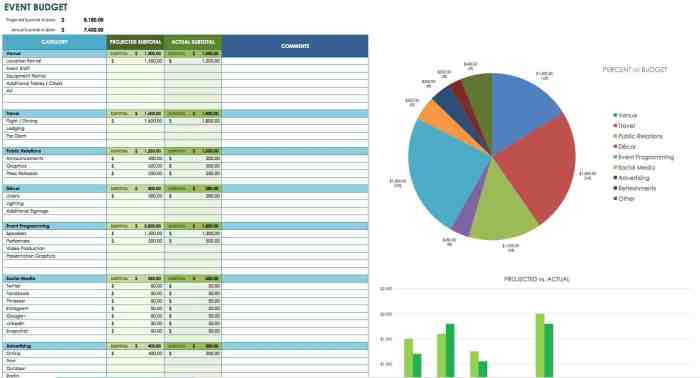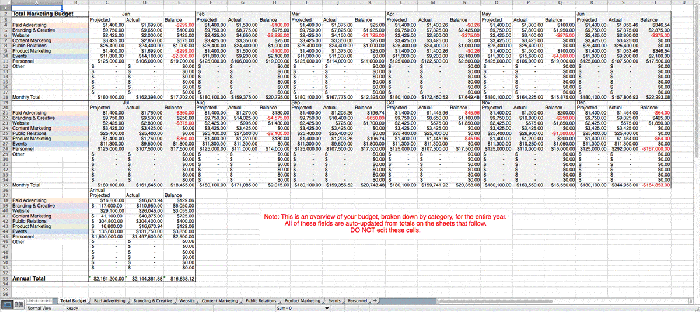Building a Marketing Budget sets the foundation for a successful marketing strategy, ensuring optimal allocation of resources and maximum ROI. Dive into the key components and strategies for creating an effective budget plan.
Overview of Marketing Budget

In the world of business, having a well-defined marketing budget is crucial for the success of any marketing campaign. It helps businesses allocate resources efficiently, track expenses, and measure the effectiveness of their marketing efforts.
Key Components of a Marketing Budget
- Digital Marketing: This includes expenses related to online advertising, social media marketing, email campaigns, and website optimization.
- Traditional Marketing: Such as print ads, television commercials, radio ads, and direct mail campaigns.
- Public Relations: Costs associated with press releases, media relations, events, and sponsorships.
- Marketing Collateral: Expenses for creating brochures, business cards, flyers, and other promotional materials.
- Staffing: Salaries, benefits, and training for marketing team members.
Recommended Percentage of Total Revenue
Experts often recommend allocating around
5-10%
of total revenue towards marketing efforts. This percentage can vary depending on the industry, business goals, and growth stage of the company.
Setting Marketing Goals

To ensure the success of a marketing budget, it is crucial to set clear and achievable marketing goals that align with the overall business objectives. By doing so, businesses can focus their resources and efforts on activities that will drive growth and profitability.
Aligning Marketing Goals with Business Objectives
When setting marketing goals, it is important to align them with the broader business objectives. This means understanding the specific needs and priorities of the business and determining how marketing can support these goals. By ensuring that marketing goals are in sync with the overall business strategy, companies can maximize the impact of their marketing efforts.
Setting SMART Marketing Goals
Setting SMART goals is a proven method for creating effective marketing strategies. SMART goals are Specific, Measurable, Achievable, Relevant, and Time-bound. This framework helps ensure that marketing goals are clear, quantifiable, realistic, and aligned with the business’s objectives. For example, a SMART marketing goal could be to increase website traffic by 20% within the next six months.
Examples of Marketing Goals
- Increase brand awareness by 25% in the next quarter through social media campaigns.
- Generate 100 new leads per month through targeted email marketing efforts.
- Improve customer retention rate by 15% by implementing a loyalty program by the end of the year.
- Boost sales conversion rate by 10% by optimizing the company website for better user experience.
Allocating Budget to Different Channels: Building A Marketing Budget
When it comes to building a marketing budget, allocating funds to different channels is crucial for reaching a diverse audience and maximizing impact.
Importance of Diversifying Marketing Channels
Diversifying marketing channels ensures that your message reaches a wide range of potential customers, increasing brand visibility and engagement.
- By spreading budget across various channels, you can mitigate risks associated with over-reliance on a single platform.
- Each channel offers unique advantages and caters to different audience segments, allowing you to tailor your approach accordingly.
- Utilizing multiple channels also helps in staying ahead of market trends and adapting to changing consumer behaviors.
Criteria for Selecting Suitable Marketing Channels
When selecting marketing channels, it’s essential to consider the target audience and overall goals of your campaign.
- Understand where your target audience is most active and tailor your strategy to reach them effectively.
- Consider the nature of your products or services and choose channels that align with their characteristics and consumer preferences.
- Evaluate the cost-effectiveness and potential ROI of each channel to ensure efficient allocation of resources.
Examples of Budget Allocation for Different Channels, Building a Marketing Budget
Depending on the nature of your business and campaign objectives, budget allocation can vary significantly across digital marketing, traditional advertising, events, and other channels.
| Marketing Channel | Allocation Percentage |
|---|---|
| Digital Marketing (Social Media, PPC) | 40% |
| Traditional Advertising (TV, Print) | 30% |
| Events (Conferences, Trade Shows) | 20% |
| Others (Email Marketing, Influencer Partnerships) | 10% |
Monitoring and Adjusting the Budget
When it comes to monitoring and adjusting your marketing budget, it’s crucial to keep a close eye on the performance of your marketing initiatives in relation to the allocated budget. This involves tracking key performance indicators (KPIs) and being prepared to make adjustments based on the data.
Tracking Key Performance Indicators (KPIs)
It’s essential to have a clear set of KPIs that align with your marketing goals and objectives. Some common KPIs to track include:
- Conversion rates
- Cost per acquisition
- Return on investment (ROI)
- Website traffic and engagement
- Social media metrics
Adjusting the Budget for Optimization
Based on the performance data gathered from tracking KPIs, it’s important to be flexible and willing to adjust your budget to optimize ROI. Strategies for adjusting the budget may include:
- Shifting funds from underperforming channels to more successful ones
- Experimenting with different tactics or campaigns to see what resonates best with your target audience
- Scaling up budget for high-performing initiatives to maximize results
- Regularly reviewing and analyzing data to identify trends and make informed decisions


